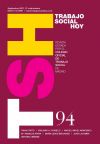La simbiosis perfecta: neurociencia y Trabajo Social
[The perfect symbiosis: neuroscience and Social Work]
Autoría: Araya Perdomo, M.ª Ángeles
Datos profesionales del autor/a: Trabajadora Social Centro de Salud de Atención Primaria de Fuerteventura
Correspondencia: M.ª Ángeles Araya. Trabajadora Social. Email: angelsarayper@yahoo.es
Recibido: 24/2/2021
Revisado: 26/6/2021
Aceptado: 9/9/2021
Publicado: 30/9/2021
Resumen
En la visión epistemológica del Trabajo Social Clínico se refleja el trabajo con la persona desde su vertiente relacional interpersonal, intrapersonal y con el ambiente, como base del paradigma del bienestar. Este fundamento se corrobora una vez más tras la aparición de la neurociencia, la cual de forma transdisciplinar evidencia la relación neurobiológica de los procesos sociales y la salud, con los correlatos neurales del dolor social y las consecuencias del aislamiento social, que nos han permitido evolucionar como especie. Posicionando al Trabajo Social frente a impensables resultados psiconeuroinmunológicos que evidencian la salud desde la primacía social.
Descarga del artículo:
Palabras Clave
Trabajo Social Clínico, Neurobiología, Sinapsis sociales, Aislamiento social, Dolor social.
Abstract
The epistemological vision of clinical social work, the work with the person is reflected from its interpersonal and intrapersonal relational aspects and with the environment, as the basis of the welfare paradigm. This foundation is corroborated once again after the appearance of neuroscience, which in a transdisciplinary way evidences the neurobiological relation of social
processes and health, with neural correlates such as social pain and the consequences of social isolation that have allowed us to evolve as a species. Positioning social work against unthinkable psychoneuroimmunological results that evidence health from the social primacy.
processes and health, with neural correlates such as social pain and the consequences of social isolation that have allowed us to evolve as a species. Positioning social work against unthinkable psychoneuroimmunological results that evidence health from the social primacy.
Key Words
Clinical Social Work, Neurobiology, Social synapses, Social isolation, Social pain.
Referencia Normalizada (cómo citar este artículo)
Araya, M.ª A. (2021). La simbiosis perfecta: neurociencia y Trabajo Social. Trabajo Social Hoy 94(75-87). doi:10.12960/TSH.20212.0015
Texto del Artículo
Referencias
Adolphs, R. (1999). Social cognition and the human brain. Cells Press.
Bargh, J. A., y Shalev, I. (2012). The substitutability of physical and social warmth in daily life: PsycNET Emotion. Asociación estadounidense de Psicología.
Biestek, F. (1996). Las relaciones de Case Work. Aguilar.
Brothers, L. (1990). The social brain: A project for integrating primate behaviour and neuropsichology in a new domain: Concepts in Neuroscience Journal 1(1), 27-51.
Brothers, L. (1997). How society shapes the human mind. Oxford University Press.
Cacioppo, J. y Hawkley, L. (2009). Perceived social insolación and cognition: Trends Cognition Sciences 13(1) 447-454.
Cole, S. (2011). Social regulation of gene expression in the immune system: Oxford Handbook of Psychoneuroimmunology. Ed. Segerstrom S. Oxford University Press.
Cozolino, L. (2006). The neuroscience of human relationships: attachment and the developing social brain. Nueva York: W. W. Norton & Co.
Dunbar R. I. M. y Shultz S. (2007). The evolucion of the social brain: anthropoid primates contrast with other vertebrates. Proceedings of the Royal Society B 274: 2429-2436.
Eisenberger, N., y Cole, S. (2012). Social neuroscience and health: neurophysiological mechanisms linking social ties with physical health. Neuroscience 15(5), 669-74.
Garcés, E. (2010). El Trabajo Social en la Salud Mental. Cuadernos de Trabajo Social, 23(1), 333-352.
Gracia Fuster, E., Herrero Olaizola, J., y Musitu Ochoa, G. (1995). El apoyo social. Barcelona. PPU. Holt-Lunstad, J., et al., (2017). Advancing Social Connection as a Public Health Priority in the United States. American Psychological Association, 72(6).
Howe, D. (2019). Critical practice in the social work. MacMallon Education. (1996). Surface and Depth in the Social Work Practice. Social theory, social change, and social work. Edited N. Parton. London, Routledge.
IFSW. (2000). Newsletter 1/2000 International Federation of Social Workers. Word conference of International Federation Social Work and International Association of Schools of Social Work. Montreal. Canada. Consulta el 19 septiembre de 2019 https://www.ifsw.org/wp-content/uploads/ifsw-cdn/assets/ifsw_33342-6.pdf
Ituarte, A. (1992). Procedimiento y proceso en Trabajo Social Clínico: Consejo General de Colegios Oficiales de Diplomados en Trabajo Social y Asistentes Sociales. Madrid.
Jairo, J., Krikorian, A., y Vélez, M. C. (2008). Aspectos neurobiológicos, psicológicos y sociales del sufrimiento 5(2-3), 245-255.
Lieberman, M. D. y Eisenberger N. I. (2006a; 2007b). A pain by any other name (rejection, exclusion, ostracism) still hurts the same: the role of dorsal anterior cingulated cortex in social and physical pain. Citado en Cacioppo, J. T., Visser, P. S. y Pickett, C. L. Social neuroscience: people thinking about thinking people Cambridge, M. A.: MIT Press.ç
McGrath, E. P. y Repetti, R. L. (2002). A longitudinal study of children’s depressive symptoms, self-perceptions, and cognitive distortions about the self: Journal of Abnormal Psychology, 111(1), 77-87.
Moieni M., y Eisenberger N. (2018). Effects of inflammation on social processes and implications for health: Ann N Y Acad Sci 1428(1), 5-13.
Moriña, A. (2007). La exclusión social: Análisis y propuestas para su prevención. Estudios de progreso. Ed. Fundación Alternativas.
National Association of Social Workers. NASW Standars for Clinical Social Work in Social Work Practice. (2005). Definitions: Clinical Social Work. Washington DC.
Laparra, M. (2007). Una propuesta de consenso sobre el concepto de exclusión. Implicaciones metodológicas: Revista Española del Tercer Sector 5(1).
Richmond, M. E. (1899-1969). Friendly visiting among the poor: A handbook for charity workers. Montclair, New Jersey: Patterson Smith.
Sánchez, M. (2016). El impacto de los avances neurocientíficos en la profesión del Trabajo Social: presente y propuestas de futuro. Documentos de Trabajo Social 57(1).
Saunders, C., y Baines M. (1983). Living with dying: The management of terminal disease. 1st. edition. Oxford: Oxford University Press.
Sen, A. (1995). Nuevo examen de la desigualdad: Alianza.
Subramanian, K. y Sheldon, D. (1988). Social Work and the Treatment of Chronic Pain. Health & Social Work 13(1), 49-60, doi.org/10.1093/hsw/13.1.49
Swidbert, R. O. y Rogers, S. (2010). Gregarious desert locusts have substantially larger brains with altered proportions compared with the solitarious phase. Proceedings of the Royal Society of London B. Biological Sciences, 277(1697), 3087-3096.
Walker, A. (2014). Neuroinflammation and Comorbidity of Pain and Depression: Pharmacological Reviews. American Society for Pharmacology and experimental therapeutics 66(1), 80-101.
Winnicott, D. (1965). The maturational processes and the facilitating environment: studies in the theory of emotional development. The International Psycho-Analytical Library 64(1),1-276.
Bargh, J. A., y Shalev, I. (2012). The substitutability of physical and social warmth in daily life: PsycNET Emotion. Asociación estadounidense de Psicología.
Biestek, F. (1996). Las relaciones de Case Work. Aguilar.
Brothers, L. (1990). The social brain: A project for integrating primate behaviour and neuropsichology in a new domain: Concepts in Neuroscience Journal 1(1), 27-51.
Brothers, L. (1997). How society shapes the human mind. Oxford University Press.
Cacioppo, J. y Hawkley, L. (2009). Perceived social insolación and cognition: Trends Cognition Sciences 13(1) 447-454.
Cole, S. (2011). Social regulation of gene expression in the immune system: Oxford Handbook of Psychoneuroimmunology. Ed. Segerstrom S. Oxford University Press.
Cozolino, L. (2006). The neuroscience of human relationships: attachment and the developing social brain. Nueva York: W. W. Norton & Co.
Dunbar R. I. M. y Shultz S. (2007). The evolucion of the social brain: anthropoid primates contrast with other vertebrates. Proceedings of the Royal Society B 274: 2429-2436.
Eisenberger, N., y Cole, S. (2012). Social neuroscience and health: neurophysiological mechanisms linking social ties with physical health. Neuroscience 15(5), 669-74.
Garcés, E. (2010). El Trabajo Social en la Salud Mental. Cuadernos de Trabajo Social, 23(1), 333-352.
Gracia Fuster, E., Herrero Olaizola, J., y Musitu Ochoa, G. (1995). El apoyo social. Barcelona. PPU. Holt-Lunstad, J., et al., (2017). Advancing Social Connection as a Public Health Priority in the United States. American Psychological Association, 72(6).
Howe, D. (2019). Critical practice in the social work. MacMallon Education. (1996). Surface and Depth in the Social Work Practice. Social theory, social change, and social work. Edited N. Parton. London, Routledge.
IFSW. (2000). Newsletter 1/2000 International Federation of Social Workers. Word conference of International Federation Social Work and International Association of Schools of Social Work. Montreal. Canada. Consulta el 19 septiembre de 2019 https://www.ifsw.org/wp-content/uploads/ifsw-cdn/assets/ifsw_33342-6.pdf
Ituarte, A. (1992). Procedimiento y proceso en Trabajo Social Clínico: Consejo General de Colegios Oficiales de Diplomados en Trabajo Social y Asistentes Sociales. Madrid.
Jairo, J., Krikorian, A., y Vélez, M. C. (2008). Aspectos neurobiológicos, psicológicos y sociales del sufrimiento 5(2-3), 245-255.
Lieberman, M. D. y Eisenberger N. I. (2006a; 2007b). A pain by any other name (rejection, exclusion, ostracism) still hurts the same: the role of dorsal anterior cingulated cortex in social and physical pain. Citado en Cacioppo, J. T., Visser, P. S. y Pickett, C. L. Social neuroscience: people thinking about thinking people Cambridge, M. A.: MIT Press.ç
McGrath, E. P. y Repetti, R. L. (2002). A longitudinal study of children’s depressive symptoms, self-perceptions, and cognitive distortions about the self: Journal of Abnormal Psychology, 111(1), 77-87.
Moieni M., y Eisenberger N. (2018). Effects of inflammation on social processes and implications for health: Ann N Y Acad Sci 1428(1), 5-13.
Moriña, A. (2007). La exclusión social: Análisis y propuestas para su prevención. Estudios de progreso. Ed. Fundación Alternativas.
National Association of Social Workers. NASW Standars for Clinical Social Work in Social Work Practice. (2005). Definitions: Clinical Social Work. Washington DC.
Laparra, M. (2007). Una propuesta de consenso sobre el concepto de exclusión. Implicaciones metodológicas: Revista Española del Tercer Sector 5(1).
Richmond, M. E. (1899-1969). Friendly visiting among the poor: A handbook for charity workers. Montclair, New Jersey: Patterson Smith.
Sánchez, M. (2016). El impacto de los avances neurocientíficos en la profesión del Trabajo Social: presente y propuestas de futuro. Documentos de Trabajo Social 57(1).
Saunders, C., y Baines M. (1983). Living with dying: The management of terminal disease. 1st. edition. Oxford: Oxford University Press.
Sen, A. (1995). Nuevo examen de la desigualdad: Alianza.
Subramanian, K. y Sheldon, D. (1988). Social Work and the Treatment of Chronic Pain. Health & Social Work 13(1), 49-60, doi.org/10.1093/hsw/13.1.49
Swidbert, R. O. y Rogers, S. (2010). Gregarious desert locusts have substantially larger brains with altered proportions compared with the solitarious phase. Proceedings of the Royal Society of London B. Biological Sciences, 277(1697), 3087-3096.
Walker, A. (2014). Neuroinflammation and Comorbidity of Pain and Depression: Pharmacological Reviews. American Society for Pharmacology and experimental therapeutics 66(1), 80-101.
Winnicott, D. (1965). The maturational processes and the facilitating environment: studies in the theory of emotional development. The International Psycho-Analytical Library 64(1),1-276.





